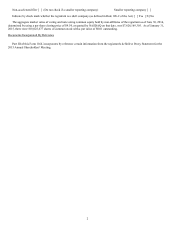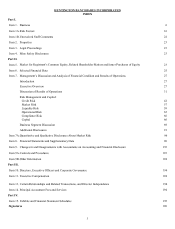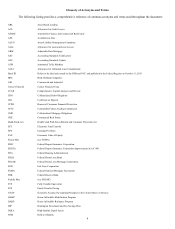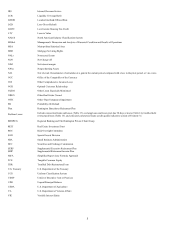Huntington National Bank 2014 Annual Report Download - page 18
Download and view the complete annual report
Please find page 18 of the 2014 Huntington National Bank annual report below. You can navigate through the pages in the report by either clicking on the pages listed below, or by using the keyword search tool below to find specific information within the annual report.12
The Volcker Rule prohibits an insured depository institution and any company that controls an insured depository institution
(such as a bank holding company), and any of their subsidiaries and affiliates (referred to as “banking entities”) from: (i) engaging in
“proprietary trading” and (ii) investing in or sponsoring certain types of funds (“covered funds”) subject to certain limited exceptions.
These prohibitions impact the ability of U.S. banking entities to provide investment management products and services that are
competitive with nonbanking firms generally and with non-U.S. banking organizations in overseas markets. The rule also effectively
prohibits short-term trading strategies by any U.S. banking entity if those strategies involve instruments other than those specifically
permitted for trading.
The final Volcker Rule regulations do provide certain exemptions allowing banking entities to continue underwriting, market-
making and hedging activities and trading certain government obligations, as well as various exemptions and exclusions from the
definition of “covered funds”. The level of required compliance activity depends on the size of the banking entity and the extent of its
trading. CEOs of larger banking entities, including Huntington, will have to attest annually in writing that their organization has in
place processes to establish, maintain, enforce, review, test and modify compliance with the Volcker Rule regulations. Banking
entities with significant permitted trading operations will have to report certain quantitative information, beginning between June 30,
2014 and December 31, 2016, depending on the size of the banking entity’s trading assets and liabilities.
On January 14, 2014, the five federal agencies approved an interim final rule to permit banking entities to retain interests in
certain collateralized debt obligations backed primarily by trust preferred securities from the investment prohibitions of the Volcker
Rule. Under the interim final rule, the agencies permit the retention of an interest in or sponsorship of covered funds by banking
entities if certain qualifications are met. In addition, the agencies released a non-exclusive list of issuers that meet the requirements of
the interim final rule. At December 31, 2014, we had investments in nine different pools of trust preferred securities. Eight of our
pools are included in the list of non-exclusive issuers. We have analyzed the other pool that was not included on the list and believe
that we will continue to be able to own this investment under the final Volcker Rule regulations.
There are restrictions on our ability to pay dividends.
Dividends from the Bank to the parent company are the primary source of funds for payment of dividends to our shareholders.
However, there are statutory limits on the amount of dividends that the Bank can pay to the holding company. Regulatory approval is
required prior to the declaration of any dividends in an amount greater than its undivided profits or if the total of all dividends declared
in a calendar year would exceed the total of its net income for the year combined with its retained net income for the two preceding
years, less any required transfers to surplus or common stock. The Bank is currently able to pay dividends to the holding company
subject to these limitations.
If, in the opinion of the applicable regulatory authority, a bank under its jurisdiction is engaged in, or is about to engage in, an
unsafe or unsound practice, such authority may require, after notice and hearing, that such bank cease and desist from such practice.
Depending on the financial condition of the Bank, the applicable regulatory authority might deem us to be engaged in an unsafe or
unsound practice if the Bank were to pay dividends to the holding company.
The Federal Reserve and the OCC have issued policy statements that provide that insured banks and bank holding companies
should generally only pay dividends out of current operating earnings. Additionally, the Federal Reserve may prohibit or limit bank
holding companies from making capital distributions, including payment of preferred and common dividends, as part of the annual
capital plan approval process.
We are subject to the current capital requirements mandated by the Federal Reserve and final Basel III capital and liquidity
frameworks.
The Federal Reserve sets risk-based capital ratio and leverage ratio guidelines for bank holding companies. Under the guidelines
and related policies, bank holding companies must maintain capital sufficient to meet both a risk-based asset ratio test and a leverage
ratio test on a consolidated basis. The risk-based ratio is determined by allocating assets and specified off-balance sheet commitments
into risk-weighted categories, with higher weighting assigned to categories perceived as representing greater risk. The risk-based ratio
represents total capital divided by total risk-weighted assets. The leverage ratio is core capital divided by total assets adjusted as
specified in the guidelines. The Bank is subject to substantially similar capital requirements.
























